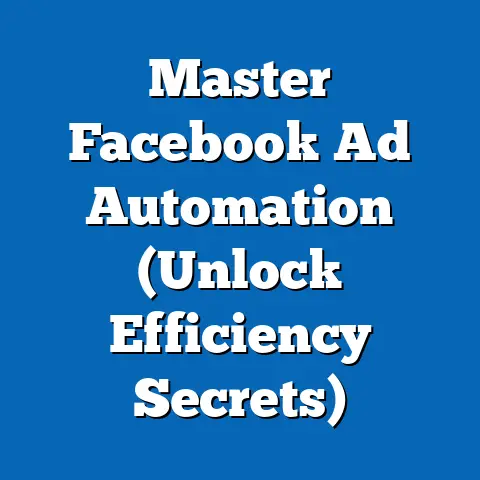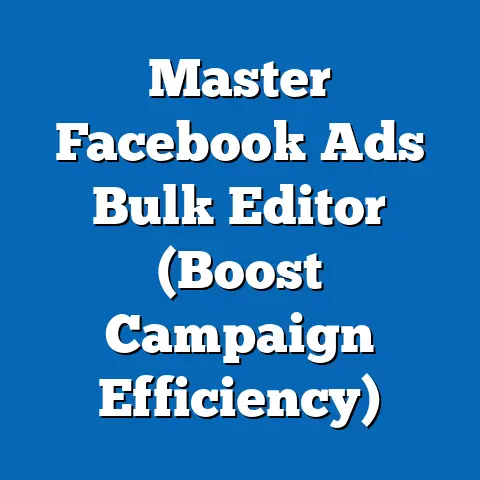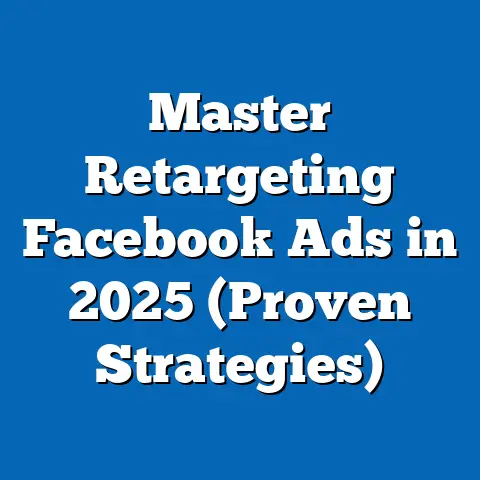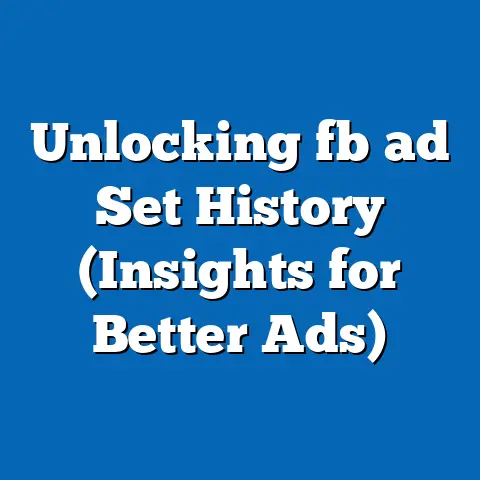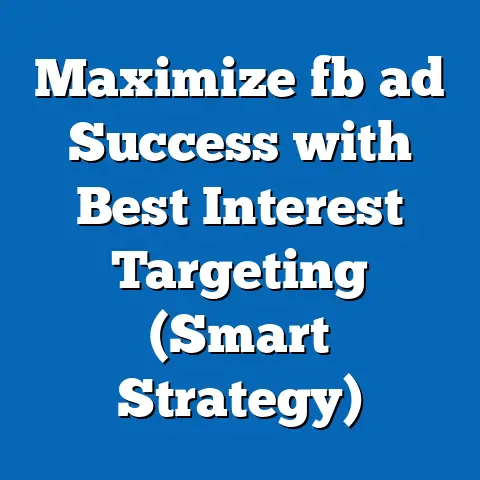Understanding Facebook Ad Conversions (Essential Insights)
In today’s digital landscape, businesses are increasingly recognizing the importance of eco-friendly products and services. As consumer awareness of sustainability grows, companies are adapting their marketing strategies to highlight their commitment to environmental responsibility. Facebook advertising offers a powerful platform to reach these eco-conscious consumers, but simply running ads isn’t enough. To truly succeed, you need to understand and optimize your Facebook ad conversions.
I’ve spent years helping businesses navigate the complexities of Facebook advertising, and I’ve seen firsthand how a deep understanding of conversions can transform a struggling campaign into a roaring success. Without it, you’re essentially throwing money into the wind, hoping something sticks. This article will break down the essential insights you need to master Facebook ad conversions, particularly when promoting eco-friendly products and services.
What are Facebook Ad Conversions?
In the world of Facebook advertising, a conversion is any desired action a user takes after interacting with your ad. It’s the ultimate goal you want to achieve, whether it’s driving traffic to your website, generating leads, or making a sale. Understanding the different types of conversions is crucial for crafting a targeted and effective ad strategy.
Here’s a breakdown of some common Facebook ad conversions:
- Page Views: This is the most basic type of conversion, tracking the number of users who visit a specific landing page after clicking on your ad. It’s a good indicator of whether your ad is attracting the right audience and if your landing page is relevant to their interests.
- Sign-ups: Encouraging users to sign up for newsletters, promotional offers, or free trials is a valuable conversion goal. This allows you to build your email list and nurture potential customers over time.
- Purchases: The holy grail of conversions! This tracks the number of transactions completed as a direct result of your Facebook ad. It’s a clear indication of your ad’s effectiveness in driving sales.
- Leads: Collecting potential customer information, such as names, email addresses, and phone numbers, is a valuable conversion for businesses looking to generate qualified leads. This is particularly important for high-value products or services that require a more personalized sales approach.
For example, let’s say you’re promoting a line of sustainable clothing made from recycled materials. You could track page views to see how many people are visiting your product page, sign-ups to build your email list for future promotions, and purchases to measure the direct impact of your ads on sales. Understanding which conversions are most valuable to your business will help you prioritize your ad efforts and optimize your campaigns for maximum impact.
Takeaway: Defining your desired conversion goals is the first step to creating a successful Facebook ad strategy.
Why Understanding Conversions is Critical for Businesses
Understanding conversions isn’t just about tracking numbers; it’s about gaining valuable insights into your audience, optimizing your ad spend, and ultimately, driving business growth. I’ve seen countless businesses struggle with Facebook ads simply because they weren’t paying attention to the data.
Here’s why understanding conversions is so critical:
- Measuring ROI: Conversions are the key to measuring the return on your advertising investment (ROI). By tracking the number of conversions generated by your ads, you can determine whether your ad spend is actually driving results. This is especially important for eco-friendly products, which may have higher production costs. You need to ensure that your advertising efforts are generating enough revenue to justify the investment. For example, if you’re spending $100 on Facebook ads and generating $200 in sales, your ROI is 2x. This allows you to justify the ad spend and scale your campaigns.
- Target Audience Insights: Analyzing conversion data can provide valuable insights into your target audience’s behavior, preferences, and purchasing habits. By understanding which ads are driving the most conversions, you can identify the demographics, interests, and behaviors of your most engaged customers. For instance, you might discover that your ads are performing particularly well among millennials interested in sustainable living. This information can then be used to refine your targeting and create more relevant ads in the future.
- Optimizing Ad Spend: Understanding conversions allows you to allocate your advertising budget more effectively. By identifying which ads are performing well and which ones are underperforming, you can shift your budget towards the campaigns that are driving the most conversions. For example, if you notice that one ad is generating a high number of sign-ups but few purchases, you might want to adjust the ad copy or targeting to focus on driving sales. I always tell my clients to “kill your darlings” – don’t be afraid to cut underperforming ads, even if you love them! The data doesn’t lie.
Takeaway: Conversions are the foundation for measuring ROI, understanding your audience, and optimizing your ad spend.
The Conversion Funnel and Facebook Ads
The conversion funnel is a marketing model that illustrates the customer journey from initial awareness to final conversion. Understanding the different stages of the funnel is crucial for crafting effective Facebook ad campaigns that guide users towards your desired goals.
The typical conversion funnel consists of three stages:
- Awareness Stage: This is the top of the funnel, where you’re aiming to reach a broad audience and create awareness of your brand and products. In this stage, you want to use engaging ads that highlight the benefits of your eco-friendly offerings. For example, you could run a video ad showcasing the sustainable materials used in your products or the positive environmental impact of your business practices.
- Consideration Stage: In this stage, you’re targeting users who are aware of your brand but haven’t yet made a purchase. You want to provide them with more information and build trust by sharing testimonials, reviews, and educational content related to sustainability. For example, you could run an ad featuring customer reviews highlighting the quality and durability of your eco-friendly products. Or, you could share an article explaining the benefits of using sustainable materials.
- Conversion Stage: This is the bottom of the funnel, where you’re targeting users who are ready to make a purchase or take another desired action. You want to create compelling calls-to-action (CTAs) that encourage them to convert. For example, you could run an ad offering a discount code for first-time buyers or a limited-time promotion on your eco-friendly products. Make sure your CTAs are clear, concise, and action-oriented, such as “Shop Now,” “Sign Up Today,” or “Get Your Free Trial.”
I’ve found that many businesses make the mistake of focusing solely on the conversion stage, neglecting the importance of building awareness and consideration. Remember, most users won’t convert on their first interaction with your brand. You need to nurture them through the funnel by providing valuable content and building trust.
Takeaway: Understanding the conversion funnel allows you to craft targeted ads that guide users towards your desired goals at each stage of their journey.
Key Metrics to Track for Facebook Ad Conversions
Tracking the right metrics is essential for evaluating the success of your Facebook ad campaigns and identifying areas for improvement. Don’t get bogged down in vanity metrics like likes and shares. Focus on the metrics that truly impact your bottom line.
Here are some key metrics to track for Facebook ad conversions:
- Conversion Rate: This is the percentage of users who take a desired action after clicking on your ad. It’s calculated by dividing the number of conversions by the number of clicks. A high conversion rate indicates that your ad is effectively driving users to take the desired action. For example, if you have 100 clicks and 10 conversions, your conversion rate is 10%.
- Cost Per Conversion: This is the average cost you pay for each conversion. It’s calculated by dividing your total ad spend by the number of conversions. A low cost per conversion indicates that your ad is cost-effective. For example, if you spend $100 on ads and generate 10 conversions, your cost per conversion is $10.
- Click-Through Rate (CTR): This is the percentage of users who click on your ad after seeing it. It’s calculated by dividing the number of clicks by the number of impressions. A high CTR indicates that your ad is engaging and relevant to your target audience. For example, if your ad is shown 1,000 times and receives 50 clicks, your CTR is 5%.
- Return on Ad Spend (ROAS): This is the revenue you generate for every dollar you spend on advertising. It’s calculated by dividing your total revenue by your total ad spend. A high ROAS indicates that your ad spending is generating a strong return on investment. For example, if you spend $100 on ads and generate $500 in revenue, your ROAS is 5x.
These metrics can provide actionable data to help you refine your future campaigns, especially for businesses promoting eco-friendly products. I always recommend setting benchmarks for each metric and tracking your progress over time. This will help you identify trends and make data-driven decisions to optimize your campaigns.
Takeaway: Tracking key metrics allows you to evaluate the success of your Facebook ad campaigns and identify areas for improvement.
Best Practices for Optimizing Facebook Ad Conversions
Optimizing your Facebook ad conversions is an ongoing process that requires continuous testing and refinement. Don’t expect to set up your campaigns and forget about them. You need to actively monitor your performance and make adjustments based on the data.
Here are some best practices for optimizing Facebook ad conversions, specifically geared toward improving Facebook ad conversions for eco-friendly brands:
- A/B Testing: A/B testing involves testing different versions of your ad creatives and target audiences to see which ones perform best. For example, you could test different headlines, images, or calls-to-action to see which ones drive the most conversions. You can also test different targeting options to see which audiences are most responsive to your ads. Facebook’s A/B testing tool makes this process relatively easy.
- Retargeting Ads: Retargeting ads allow you to re-engage users who have shown interest in your products or services but haven’t yet converted. For example, you could retarget users who have visited your website but haven’t made a purchase. You can also retarget users who have added items to their cart but haven’t completed the checkout process. Retargeting is a powerful way to remind users of your brand and encourage them to take action.
- Utilizing Facebook Pixel: The Facebook Pixel is a small piece of code that you can install on your website to track user interactions. This allows you to track conversions, optimize your ad targeting, and create custom audiences. For example, you can use the Pixel to track the number of users who visit your product pages, add items to their cart, or complete a purchase. This data can then be used to create retargeting campaigns and optimize your ad targeting. I consider the Pixel to be non-negotiable for any serious Facebook advertiser.
Staying updated with Facebook’s advertising features is also crucial for enhancing conversion rates. Facebook is constantly rolling out new features and tools, so it’s important to stay informed and experiment with them.
Takeaway: Continuous optimization through A/B testing, retargeting, and the Facebook Pixel is essential for maximizing your Facebook ad conversions.
Conclusion
Understanding Facebook ad conversions is essential for any business looking to succeed in today’s digital landscape, especially those promoting eco-friendly offerings. By mastering these insights, you can not only improve your marketing efforts but also align with broader consumer trends toward sustainability.
I encourage you to take actionable steps in analyzing your ad performance and refining your strategies to better connect with an eco-conscious audience. Start by defining your conversion goals, tracking the right metrics, and continuously optimizing your campaigns. With a data-driven approach and a commitment to sustainability, you can achieve significant results with your Facebook advertising efforts. Don’t be afraid to experiment, learn from your mistakes, and adapt your strategies as needed. The world of Facebook advertising is constantly evolving, so it’s important to stay agile and embrace change.

